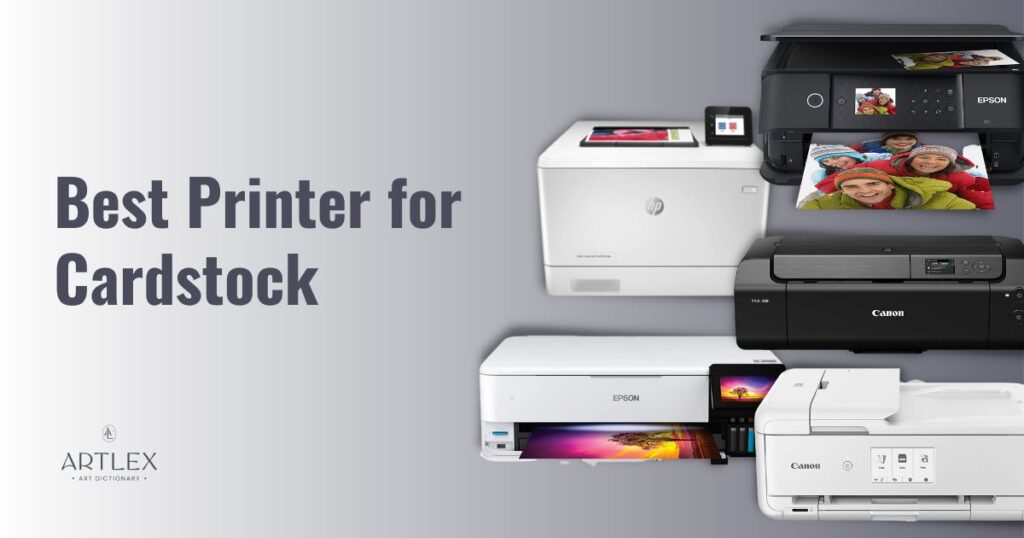
Hello, my fellow craft enthusiasts! If you know anything about us, you’d know we adore the magic of creating something beautiful with our own hands. From the delicate precision of die-cut creations to the textured charm of embossed cards and the versatility of our trusty Cricut, we’ve danced with numerous materials and crafting techniques.
But you know what we’ve found? No matter the complexity of your design or the uniqueness of your concept, the final output – that tangible token of your creativity – often relies heavily on one unassuming office hero: your printer.
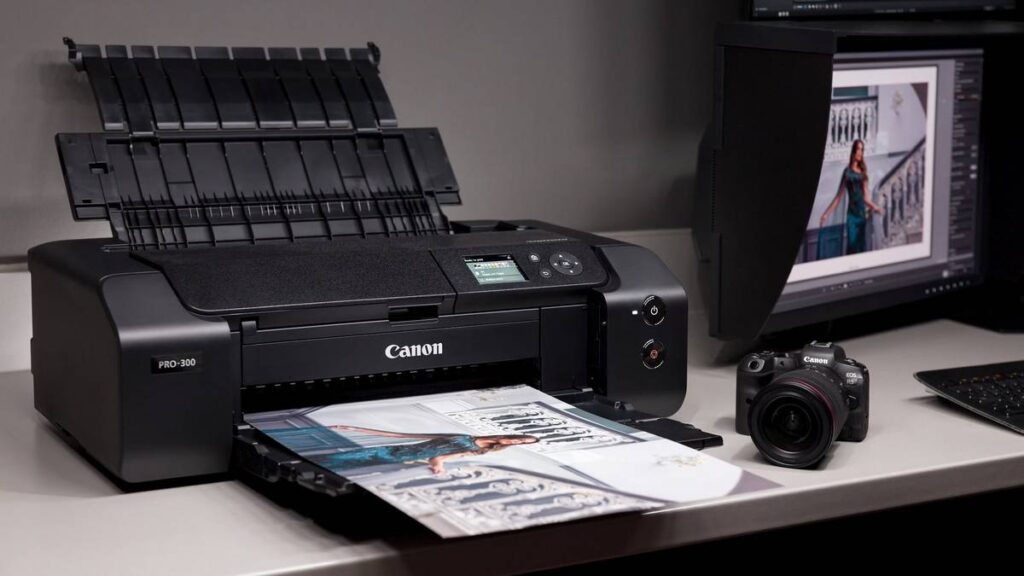
We’ve had our fair share of printers over the years, and it’s no easy task finding the one that can handle cardstock like a dream, producing crisp, vivid prints without damaging the paper or draining your wallet. That’s why we’ve decided to bring you this guide that contains all the well aquired knowledge about printing and card making to help you find the best printer for cardstock!
Our Top Printer Recommendations
- Best Printer for Cardstock Overall – Canon PIXMA PRO200
- Best Laser Printer for Cardstock – HP Color LaserJet Pro M454dw
- Best Refillable Printer for Cardstock – Epson EcoTank Photo ET-8550
- Best Professional Printer for Cardstock – Canon Pixma Pro300
- Best Budget Printer for Cardstock – Epson Expression Premium XP-6100
- Best Value Printer for Cardstock – Canon Pixma TS9521C
1. Best Printer for Cardstock Overall – Canon PIXMA PRO-200
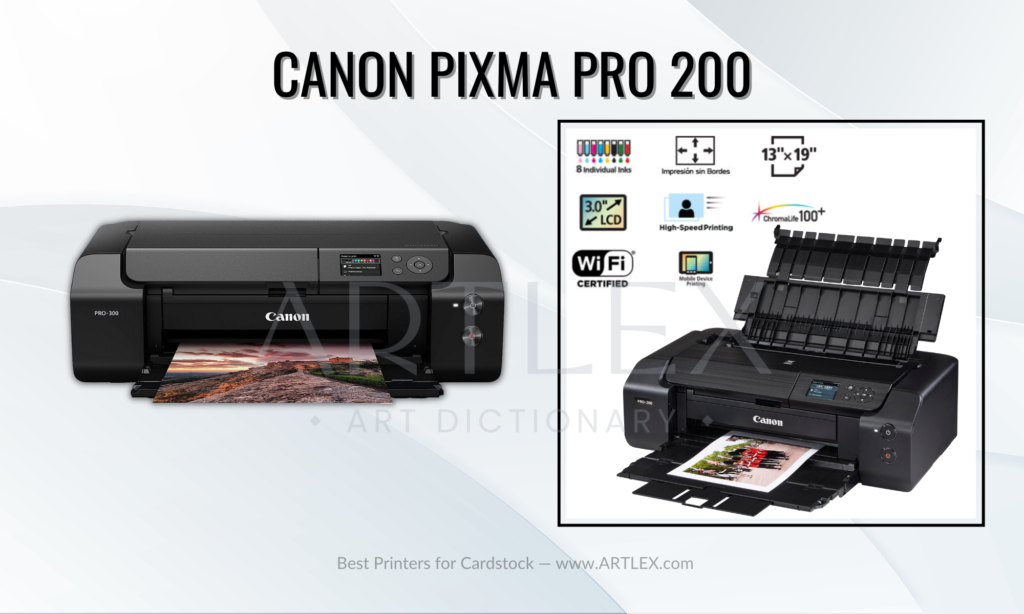
Selection Criteria
- Cardstock Compatibility: Cardstock up to 300gsm
- Our Score – 9/10
- Printing Size and Resolution: Up to 13×19 inches, 4800 x 2400 dpi resolution
- Our Score- 9/10
- Connectivity: Wifi, USB, Ethernet. Air Print Supported
- Our Score – 10/10
- Ink Type: Dye-based
- Our Score – 8/10
- Price: Approx. $600
- Our Score – 8/10
About the Canon PIXMA PRO-200
The canon PIXMA PRO 200 is a well known machine in the world of printing, being often considered as the best choice for professional art prints and photo printing, this printer has a stunning printing resolution of 4800 x 2400 dpi, which ensures every detail of your work is captured and properly portrayed in your chosen media.
This printer works with both dye-based and pigment-based ink which is great for those who want their prints to last a lifetime, and for those who want the amazing color intensity only dye-based ink can produce.
Additionally, its printing size capacity accommodates media up to 13 x 19 inches and 300 gsm, making it the perfect crafting companion for crafters and card-makers. Although its prize is on the expensive side, it can very well be considered an investment rather than an expense, since this printer will last you for years and will always deliver the best results.
Pros
- Excellent color accuracy and detail
- Wide variety of paper handling
- Convenient connectivity options
Cons
- High upfront cost
- Ink can be expensive to replace
- Not designed for high-volume printing
2. Best Laser Printer for Cardstock – HP Color LaserJet Pro M454dw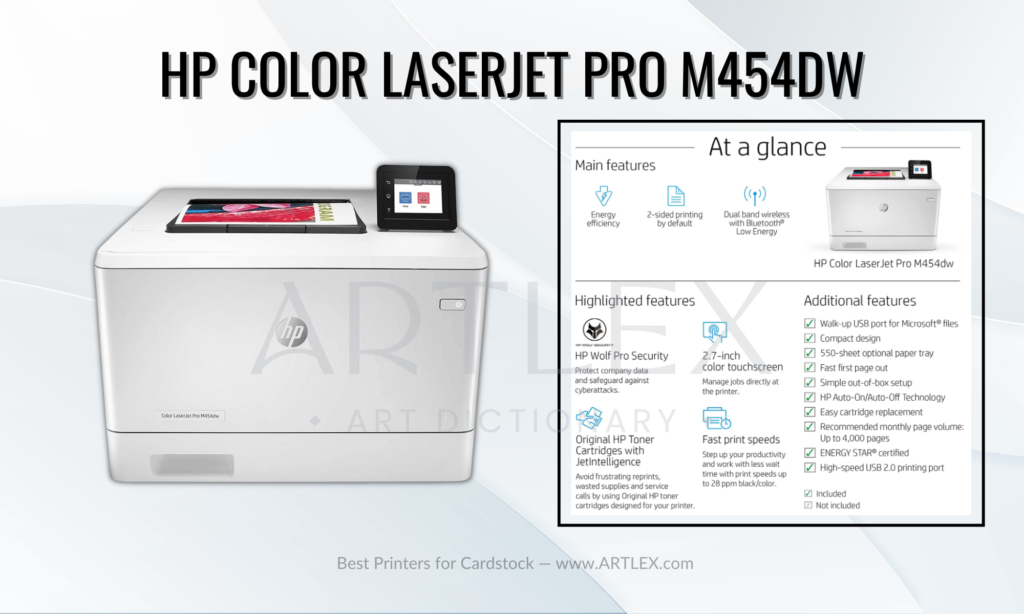
Selection Criteria
- Cardstock Compatibility: Cardstock up to 220gsm
- Our Score – 8/10
- Printing Size and Resolution: Up to Legal size (8.5 x 14″), 600 x 600 dpi resolution
- Our Score- 8/10
- Connectivity: Wifi, USB, Ethernet. Air Print Supported
- Our Score – 10/10
- Ink Type: Toner
- Our Score – 9/10
- Price: Approx. $450
- Our Score – 8/10
About the HP Color LaserJet Pro M454dw
Sometimes an inkjet printer doesn’t cut it, or sometimes it’s more than what we need, the printing speed f an inkjet can’t compare to what a laser printer can produce, and when talking bussines, that makes a huge difference.
That’s why the HP Color LaserJet Pro M454dw is the best choice for those who want to rely on the fast speed of laser printing but don’t want to sacrifice quality at the same time. This printer can handle several types of media, and ensures perfect prints every time without wapring or damaging your materials.
It comes with a 2.7″ led screen for easy setup and use, and with the HP Instant Ink program, you won’t have to worry about hard-to-find toner replacements or ink cartridges.
Pros
- Fast printing speeds
- High-quality color prints
- Robust security features
Cons
- May struggle with heavy cardstock
- Toner can be expensive to replace
- Limited maximum print size
3. Best Refillable Printer for Cardstock – Epson EcoTank Photo ET-8550
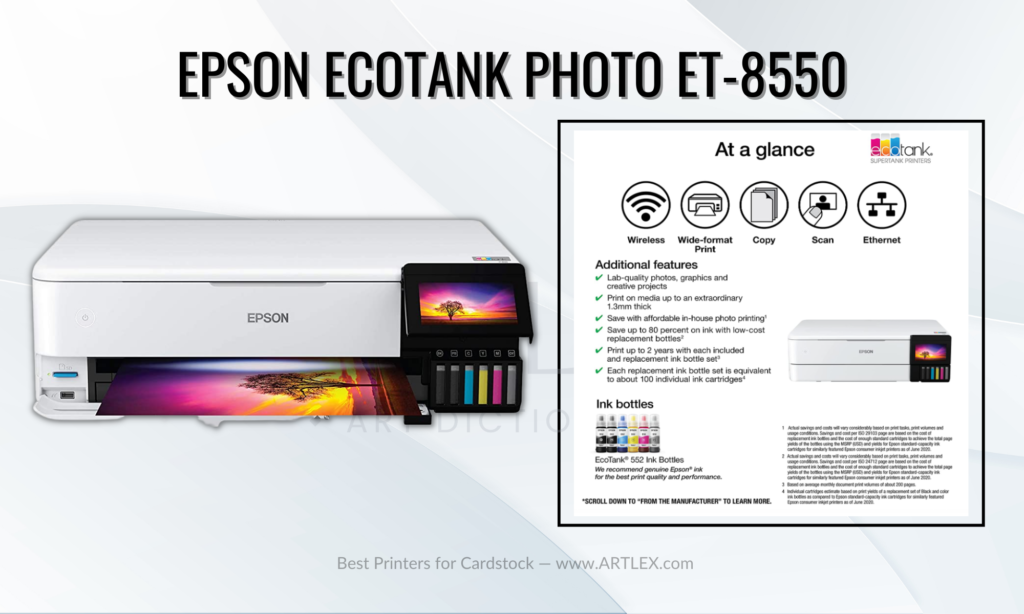
Selection Criteria
- Cardstock Compatibility: Cardstock up to 300gsm, Up to 13″ x 19″
- Our Score – 9/10
- Printing Size and Resolution: Up to 13×19 inches, 5760 x 1440 dpi resolution
- Our Score- 10/10
- Connectivity: Wifi, USB, Ethernet. Air Print Supported
- Our Score – 10/10
- Ink Type: Dye-based (Epson Claria)
- Our Score – 9/10
- Price: Approx. $700
- Our Score – 8/10
About the Epson EcoTank Photo ET-8550
When looking for a printing solution that can handle wide format printing and that is very cost effective at the same time, the Epson Ecotank ET-8550 in the way to go. This printer has an integrated refillable ink system which lasts up to two years and can be easily re-filled with Epson Ink which is very cheap in comparison with cartridges.
The ET-8550 can also print in wide format, having a limit of 13 x 19 inches and can easily print in cardstock, photo paper and fine art paper. Its 6-color system ensures high quality prints with vivd colors making it one of the best cardstock printers for artists in the market.
Additionally, this printer is quite fast, being able to print a whole standard size page in less than 20 seconds, which is great for an inket printer. Although this printer is also on the expensive side, it’s a great investmet taking into account the cost per print and the ammoun you’ll be able to save on the long run.
Pros
- Superior print quality
- Supports a variety of media types and sizes
- Low running costs
Cons
- High upfront cost
- Slow print speed
- Single paper input tray
4. Best Professional Printer for Cardstock – Canon PIXMA PRO-300
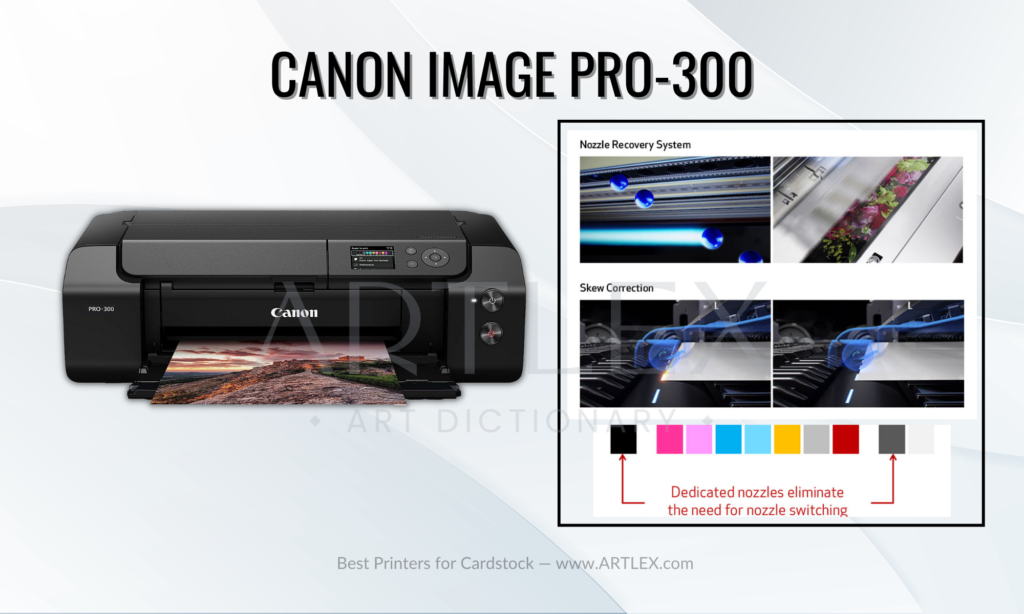
Selection Criteria
- Cardstock Compatibility: Cardstock up to 400gsm, Up to 13″ x 39″
- Our Score – 10/10
- Printing Size and Resolution: Up to 13×19 inches, 4800 x 2400 dpi resolution
- Our Score- 9/10
- Connectivity: Wifi, USB, Ethernet. Air Print Supported
- Our Score – 10/10
- Ink Type: Pigment-based
- Our Score – 10/10
- Price: Approx. $900
- Our Score – 7/10
About the Canon PIXMA Pro-300
The Canon PIXMA Pro-300 is the best inkjet printer in the market, it’s designed for photographers and artists who want to bring their digital creations to life. Boasting a 10-color Chroma Optimizer ink system, the Pro-300 aims to deliver a wide color gamut with enhanced black density and reduced bronzing. Since the ink is pigment-based instead of dye-based, your prints will last a lifetime without fading or losing intensity.
With a high print resolution of up to 4800 x 2400 dpi, the PIXMA Pro-300 ensures exceptional detail and texture in every print. Moreover, this printer can accommodate various media types, including fine art, glossy, and matte papers, with a maximum paper weight of up to 350gsm.
One of the key aspects of the PIXMA Pro-300 is its connectivity options, as it supports both wired and wireless printing. This means you can print directly from your computer, laptop, or even your smartphone. Additionally, the Pro-300 integrates seamlessly with professional editing software through Canon’s Professional Print & Layout software, allowing for a smooth workflow from editing to printing.
Pros
- Superior print quality
- Supports a variety of media types and sizes
- Low running costs
Cons
- High upfront cost
- Slow print speed
- Single paper input tray
5. Best Budget Printer for Cardstock – Epson Expression XP-6100
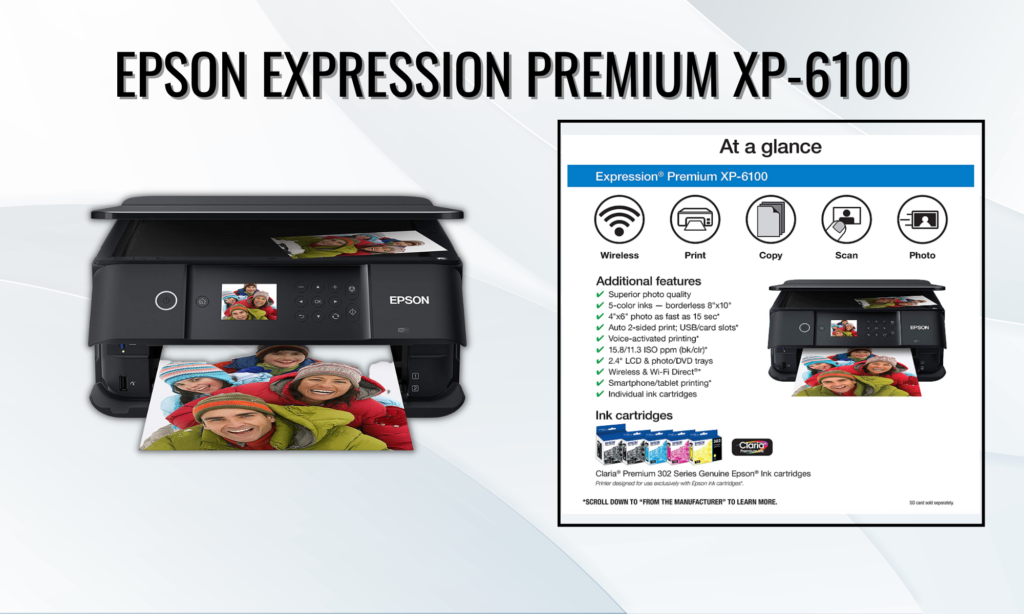
Selection Criteria
- Cardstock Compatibility: Cardstock up to 200gsm, Up to 8.5″ x 11″
- Our Score – 7/10
- Printing Size and Resolution: Up to 8.5×11 inches, 5760 x 1440 dpi resolution
- Our Score- 7/10
- Connectivity: Wifi, USB, Ethernet. Air Print Supported
- Our Score – 9/10
- Ink Type: Dye-based (Epson Claria)
- Our Score – 8/10
- Price: Approx. $150
- Our Score – 9/10
About the Epson Expression XP-6100
For thos in a tight budget , we have the Epson Expression Premium XP-6100, a small all-in-one printer known for its affordability and its ability to handle a variety of media, including cardstock. It uses five-color Claria Premium Ink to produce sharp, detailed prints with smooth gradations, making it particularly beneficial for printing photos or designs on cardstock and thicker media. With a printing speed of up to 11 pages per minute in monochrome and color, it provides efficient performance for its price.
The XP-6100 features a 100-sheet main tray and a 20-sheet photo paper tray, and can handle various media sizes. In addition to printing, this printer also includes scanning and copying functionalities, adding to its versatility for both home and small office use.
On the connectivity front, the XP-6100 supports wireless printing and is compatible with Epson’s iPrint mobile app, allowing for direct printing from smartphones and tablets. It also supports Wi-Fi Direct for a network-free connection to your devices. Despite its multiple capabilities, the XP-6100 maintains a compact design, making it a suitable option for spaces where room is at a premium. Despite the budget-firendly cost, remember to take into account the cost of ink cartridges which can be a consideration for some users.
Pros
- Compact size
- Good print quality
- Affordable upfront cost
Cons
- Limited media handling
- High running costs
- No automatic document feeder
6. Best Value Printer for Cardstock – Canon Pixma TS9521C
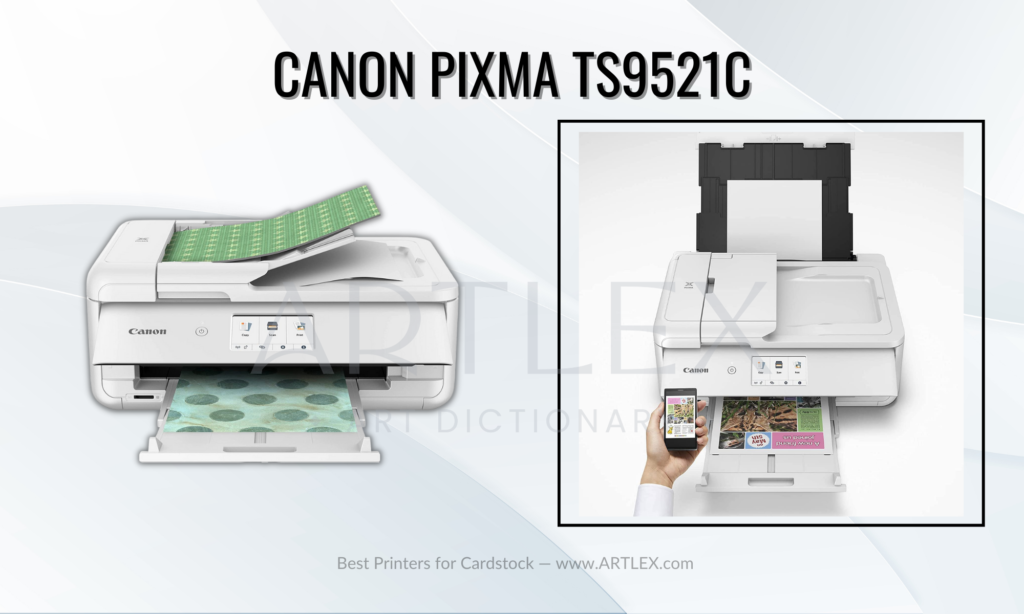
Selection Criteria
- Cardstock Compatibility: Cardstock up to 300gsm, Up to 12″ x 12″
- Our Score – 9/10
- Printing Size and Resolution: Up to 11×17 inches, 4800 x 1200 dpi resolution
- Our Score- 9/10
- Connectivity: Wifi, USB, Ethernet. Air Print Supported
- Our Score – 10/10
- Ink Type: Pigment-based and Dye-based (Hybrid)
- Our Score – 9/10
- Price: Approx. $250
- Our Score – 9/10
About the Canon Pixma TS9521C
The Canon Pixma TS9521C, is one of the best printers made especially for crafters, it provides an excellent balance of features, performance, and price, making it a great value, especially for those who frequently work with cardstock.
As an all-in-one printer, it can print, scan, and copy and it’s designed to accommodate a wide array of paper types and sizes, and is particularly well-suited for crafting projects with its ability to print sizes up to 12″ x 12″.
In terms of print quality, the TS9521C uses a 5-color individual ink system, which helps ensure high-quality prints, particularly when dealing with color or photo printing. It can reach a maximum resolution of 4800 x 1200 dpi and also supports automatic duplex printing, which can save time and paper for double-sided projects. On the connectivity front, the TS9521C offers several options, including Wi-Fi and Ethernet. It also supports direct printing from smartphones or tablets using services like AirPrint and Mopria Print Service.
Pros
- Excellent print quality
- Supports a variety of craft-oriented print sizes
- Comprehensive connectivity options
Cons
- Running costs can be high
- No automatic document feeder
- Single paper input source
Here, I’ll be sharing the printers that have truly earned their place on my craft table. These champions handle different weights and sizes of cardstock with ease, delivering stunning prints that will make your cards stand out from the crowd. But I won’t stop there. I’ll also share some insider tips on what to look for when buying a cardstock printer.
Understanding Cardstock
Cardstock, also known as cover paper, is a thicker and more durable material than your standard printer paper. The thicker nature of cardstock makes it perfect for many crafting projects, including embossed and die-cut cards, as well as Cricut creations.
Types of Cardstock
Navigating the world of paper weights can sometimes be a little daunting, especially when it comes to cardstock. Different projects require different types of cardstock, and understanding their weight is crucial for obtaining the perfect finish. Let’s dive into a more in-depth guide to help you choose the right cardstock for your projects.
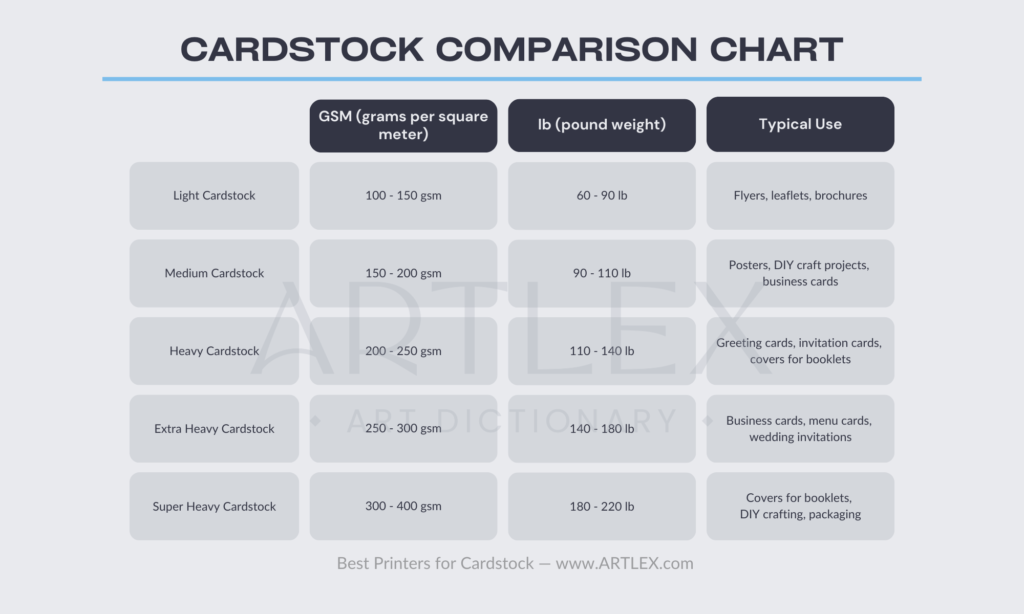
Starting on the lighter end of the spectrum, we have the Light Cardstock. This type of cardstock weighs between 100 – 150 gsm (grams per square meter), which translates to approximately 60 – 90 lb (pound weight). Lightweight and flexible, it’s ideal for everyday printing needs such as flyers, leaflets, and brochures. This cardstock is perfect for those looking to mass-produce print materials while maintaining a degree of durability and quality.
Next up is Medium Cardstock, weighing between 150 – 200 gsm (or about 90 – 110 lb). This is a step up in terms of thickness and sturdiness. It’s a great choice for projects that require a bit more rigidity without being overly heavy. This includes posters, DIY craft projects, or business cards. Its weight strikes a nice balance, offering a high-quality feel without the bulk of heavier cardstocks.
Heavy Cardstock, as the name suggests, offers even more weight and thickness, falling in the range of 200 – 250 gsm (around 110 – 140 lb). This type of cardstock is commonly used for items such as greeting cards, invitation cards, and covers for booklets. It offers a significantly sturdier feel, adding a touch of professionalism and elegance to your projects.
Moving into the upper end of the weight scale, we have Extra Heavy Cardstock, which typically weighs between 250 – 300 gsm (140 – 180 lb). With a robust and thick feel, it’s often used for more premium applications, such as high-end business cards, menu cards, and wedding invitations. When you want your project to exude quality and durability, this is the cardstock to go for.
Finally, for the most heavyweight applications, we have the Super Heavy Cardstock, which weighs between 300 – 400 gsm (around 180 – 220 lb). This weighty cardstock is ideal for projects that need to be extra durable and substantial, such as covers for booklets, certain types of DIY crafting, and even packaging.
The weights listed here are just guidelines, and actual weights can vary between different manufacturers. If possible, always do a test print with your specific printer and cardstock to ensure you’re happy with the results before embarking on a large project.
How to Print on Cardstock
Now that you understand the basics of cardstock, let’s delve into how to print on it. Here’s a step-by-step guide:
– Check your Printer’s Capabilities: Not all printers can handle cardstock, so it’s essential to check your printer’s specifications first. Look for its maximum paper weight capability. If your cardstock is heavier than your printer can handle, it can lead to paper jams or damage the printer.
– Prepare your Cardstock: Ensure your cardstock is flat and free of any creases or bends. Any imperfections can cause the paper to jam in the printer.
– Adjust Printer Settings: Before you print, adjust your printer’s settings to accommodate cardstock. Choose the “thick paper,” “heavy paper,” or “cardstock” option. If your printer doesn’t have a specific setting for cardstock, you can use the “cotton” or “matte” paper setting as a substitute.
– Load the Cardstock Correctly: Load the cardstock into the printer’s paper tray. Make sure it fits snugly and doesn’t exceed the maximum paper capacity. If your printer has a rear manual feed slot, it may be a better option as it provides a straighter path for the cardstock.
– Print a Test Page: Always print a test page first on regular paper to ensure your design will print correctly on the cardstock.
– Monitor the Printing Process: Keep an eye on the printer while it prints on cardstock to promptly address any potential issues or paper jams.
Remember, every printer is unique, and what works for one might not work for another. It’s always best to start with your printer’s user manual for specific instructions.
Bordered vs Borderless Printing: Why it Matters in Cardstock Printing
Printing terms can sometimes feel like a foreign language, especially when you’re just starting out. Among these, ‘bordered’ and ‘borderless’ printing are often thrown around, but what do they mean, and why should you care when it comes to cardstock printing? Well, let’s break it down.
Bordered printing, as the name suggests, leaves a small, unprinted margin or border around the edge of the paper. This is the default setting on most printers, and it’s generally a safe choice if you’re unsure of your printer’s capabilities. It’s less likely to cause paper jams or other issues, as the printer rollers can firmly grip the non-printed edges.
Borderless printing, on the other hand, allows your design to print right to the very edge of the paper – no margins, no white spaces, just a seamless expanse of your stunning design. It gives a professional, print-shop quality to your work, making it an ideal choice for invitations, professional presentations, or any project where you want to make a strong visual impact.
However, as with all printer-related things, it’s not as simple as choosing the one that looks best. Not all printers are capable of borderless printing, and those that are often only offer it for specific paper sizes. Printing bordereles can also make your printer prone to issues like really bad paper jams or smudging, especially when dealing with heavier materials like cardstock.
So, which one should you choose for your cardstock printing? The answer, like so many things in life, depends on what you’re trying to achieve.
If you’re after a professional finish and your printer can handle it, then borderless is a fantastic choice. Just remember to check the specifications and be prepared for the occasional misfeed or smudge. Also, be aware that borderless printing often uses more ink, as the printer will overprint the edge of the paper to ensure complete coverage.
On the other hand, if you’re more concerned with reducing potential issues, or your printer isn’t equipped to create borderless prints, then bordered printing will serve you well. It might not have quite the same ‘wow’ factor, but it’s a reliable, easy choice that can still produce beautiful results, and you can always trim the border for a more professional look.
Types of Printers
Inkjet Printers
Inkjet printers are the most common printers on the market and also a popular choice for cardstock printing. They work using nozzles that spray and overlay small drops of different color inks to create different color combinations and intensities. This method allows inkjet printers to print high quality images wirth ease and to generate vibrant colors.
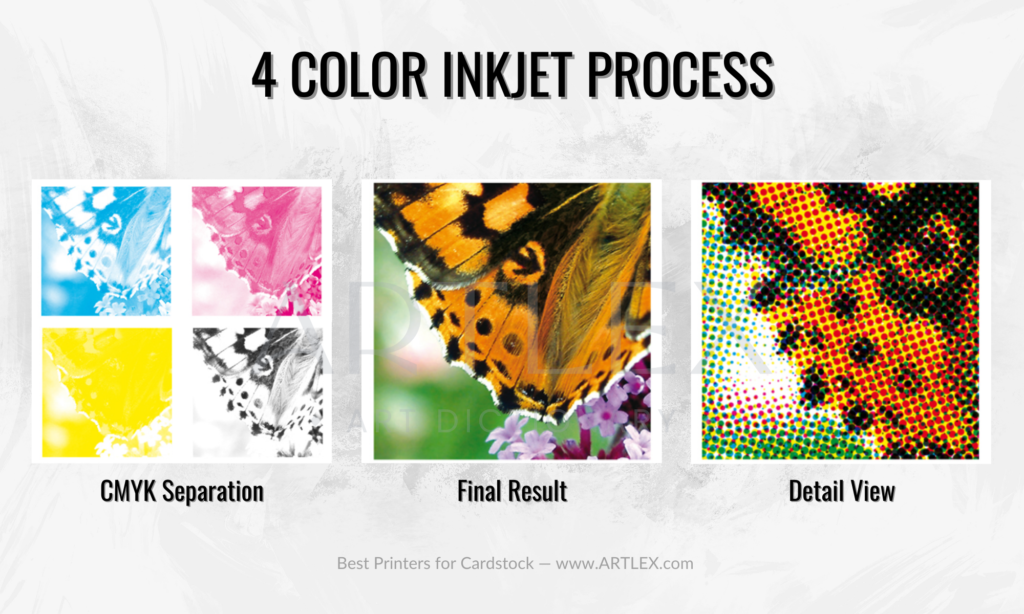
These printers are particularly good for printing on a variety of materials, including cardstock, thicker media, photo paper, fine art paper, etc since these materials are designed to “absorb” ink.
Inkjet printers can work with dye-based or pigment-based ink, and some printers can use both, which is great for creating art prints and posters that can last up to 100 years. They typically have adjustable paper trays that can handle different weights and sizes of paper, making them an excellent choice for artists and crafters who want to experiment with different types of cardstock.
However, keep in mind that not all inkjet printers are created equal. Some are better equipped to handle the weight and thickness of cardstock than others. Be sure to check the printer’s specifications before making a purchase to ensure it can accommodate your needs.
Laser Printers
Laser printers operate by using a roller system to adhere powdered ink to previously electromagnetically charged paper and then heat to it fuse onto the paper. This process results in crisp, professional-looking prints, however we must metion that the qualtity and color intensity of a laser printer doesn’t compare to what an inkjet printer can achieve.
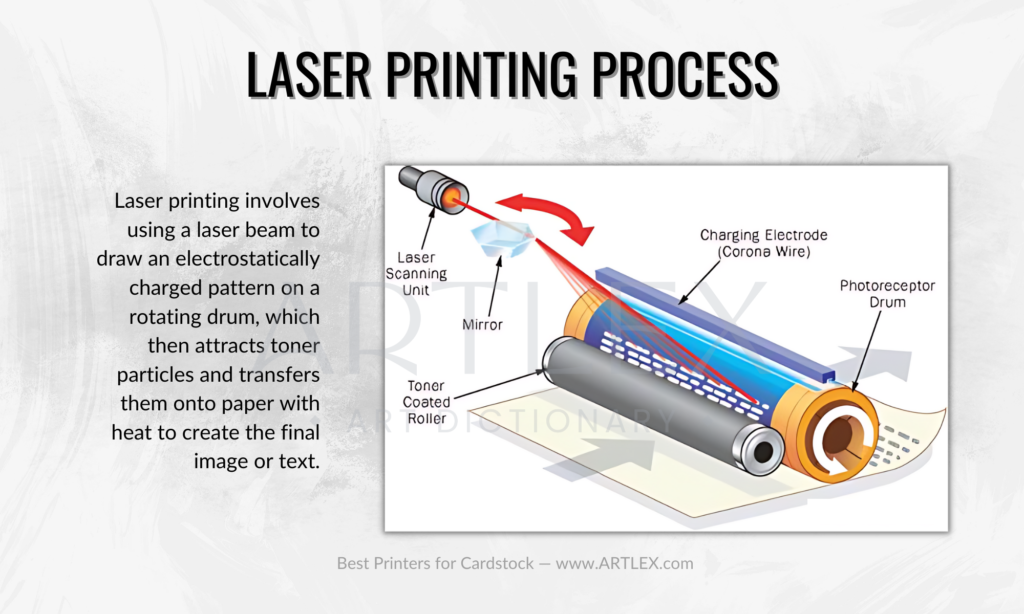
Laser printers are typically faster than inkjet printers and can handle high-volume printing tasks more efficiently and are great for cardstock invitations, greeting cards and anything that requires a faster pritning speed and doens’t involve intense colors and complex designs.
When it comes to cardstock, laser printers can deliver excellent results. They are known for their precision, which makes them great for detailed work like intricate die-cuts or embossed designs. However, it’s important to note that the rolling system and heat generated by laser printers can sometimes cause issues with thicker materials like warping or curling.
As with inkjet printers, not all laser printers can accommodate cardstock. Some have limitations on the weight of the paper they can handle. So, as always, make sure to check the printer’s specifications.
How to Find the Best Cardstock Printer
Cardstock Compatibility
In the bustling world of arts and crafts, the very first thing to consider when hunting for the perfect printer is its compatibility with cardstock. Don’t be fooled – not all printers can print on all the types of cardstock.
Cardstock comes in a variety of types, categorized by their weight, finish, and color:
– Weight: The weight of cardstock is an important consideration. It’s measured in pounds (lbs) or grams per square meter (gsm). Standard cardstock usually falls between 80lb to 110lb or 216gsm to 300gsm, suitable for most home printers. However, heavier cardstock (up to 120lb or 325gsm) is used for projects that require extra sturdiness.
– Finish: The finish of the cardstock can drastically change the look and feel of your project. It can range from a smooth, matte finish to a glossy finish, or even a textured finish such as linen or canvas. The finish you choose depends on your project’s needs.
– Color: Cardstock is available in a wide array of colors, and some are even multi-colored or patterned. From pure whites and deep blacks to vibrant reds and soothing pastels, the color of your cardstock can set the tone for your entire project.
To make sure your future printer can deal with these stubborn papers, you must check the printer’s specifications for its maximum paper weight capacity. A printer suitable for cardstock should comfortably handle at least 110lb to 120lb cardstock. Don’t settle for less, especially if you’re planning on creating projects with deep embossing or complex patterns.
The best way to find if your printer or the printer you plan to get is compatible with card6is to go to the manufacturer’s website and check the technical specifications. There you’ll find a “compatible media” section and a “paper weight” section.
Printing Size and Resolution
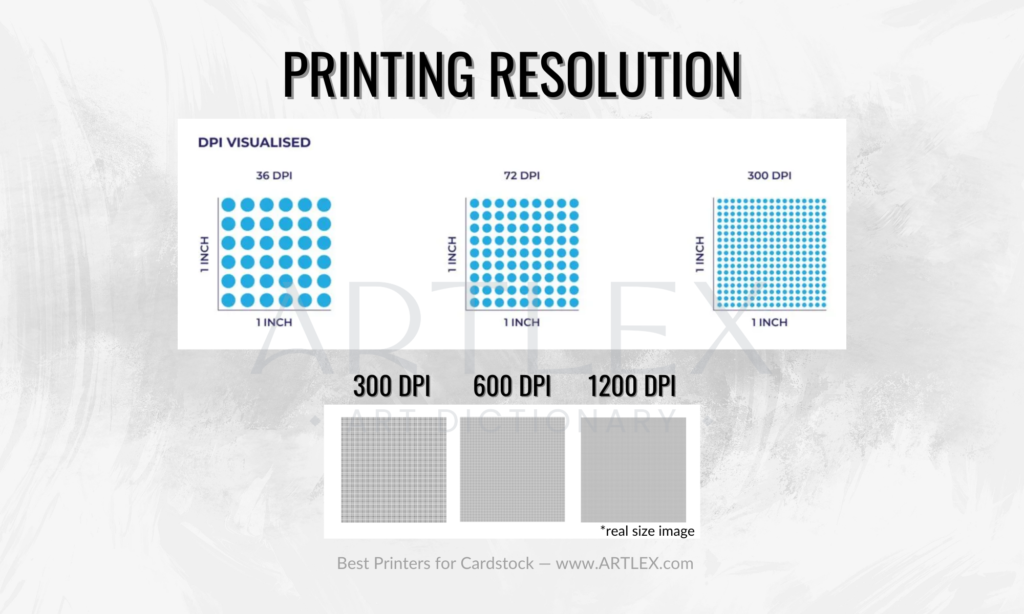
Size and resolution are the lifeblood of any project. For all those late-night moments where you meticulously perfect every detail, you want a printer that can deliver high-quality, vivid prints.
The resolution of a printer is measured in DPI (dots per inch). A higher DPI means a printer can pack more ink dots in each inch of the print, leading to a more detailed and vibrant image. For the crispest images, aim for a printer with at least 1200 x 1200 DPI.
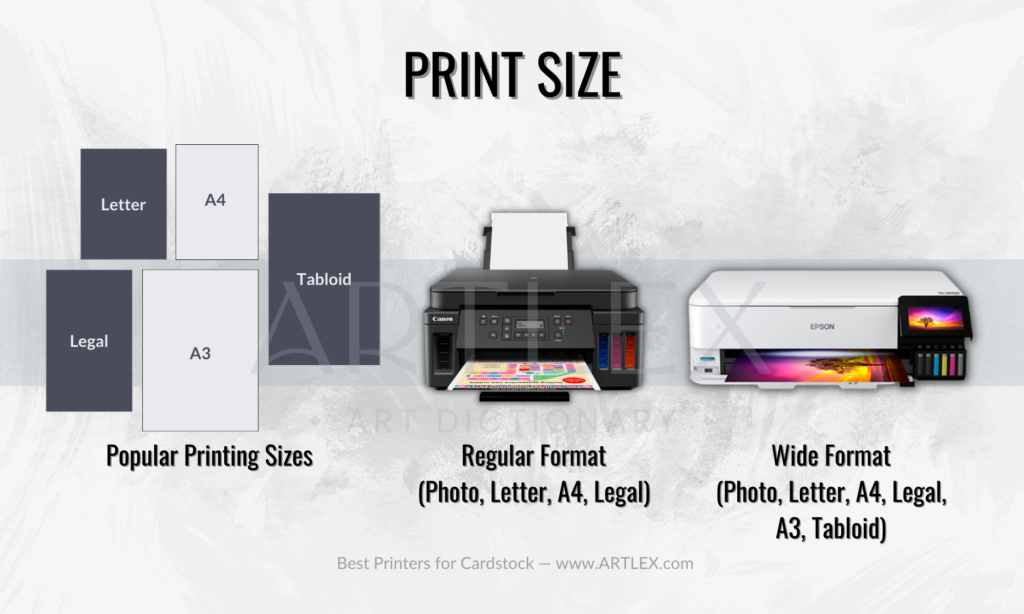
When it comes to size, flexibility is key. As crafters, we often need to print on a variety of paper sizes. Ensure your printer can accommodate diverse sizes, from the smaller A6 or 4″x6″ for petite projects, up to legal or even 13″x19″ for larger prints. A printer with an adjustable paper tray will be your best ally here.
Although there are printers with double trays, we don’t recommend them since sometimes the software switches one for the other, causing ink and material waste.
Connectivity
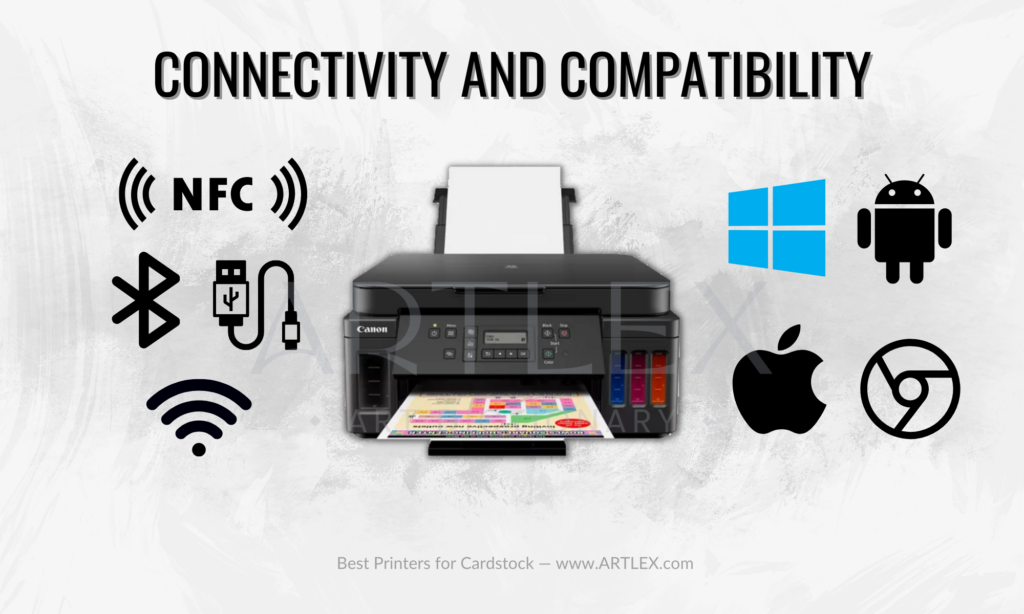
In today’s digital age, the ability to print from multiple devices is more of a necessity than a luxury. Gone are the days when printers only connected through a labyrinth of wires.
Look for a printer that offers Wi-Fi or Bluetooth connectivity, as this will allow you to print from your computer, phone, or tablet, without needing to transfer files. This is particularly useful if you’re designing on a tablet or iPad or if you’re sharing designs with others. If you’re an Apple user, then a printer that is Air Print compatible is also a must have, so check the compatibility chart and make sure your printer can be used with Apple mobile devices.
Moreover, cloud-based printing features can be a bonus, enabling you to print from cloud storage services like Google Drive or Dropbox. This can be a real time-saver, especially if you use multiple devices for your projects.
Ink Type
Let’s dive into the world of printer inks. Two main types of inks are commonly used in printers: dye-based inks and pigment-based inks. Both have their perks and mehs, so it’s essential to understand the difference to make the best choice for your crafting needs.
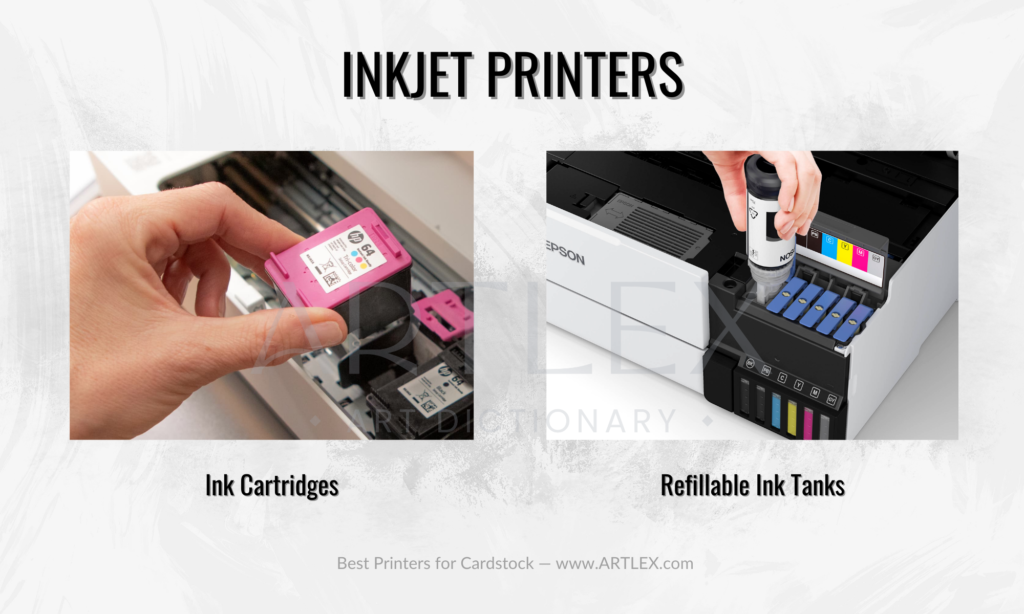
Dye-based inks are known for their vibrant and glossy finishes. They’re perfect for designs where bright, popping colors are a must. However, they tend to fade quicker, especially when exposed to light and heat. Dye based ink is great for thos prints you are not selling professionally since they’ll most likely fade in 3 – 4 years, and even less when exposed to sunlight.
On the other hand, pigment-based inks are acclaimed for their durability. They’re archival, resistant to fading and can withstand the test of time, which is great for projects that you want to keep around for a long time since they can last up to 100 years.
However, they might not deliver the same level of vibrancy as dye-based inks, are much more expensive and tend to clog easily requiring ink-consuming cleanings from time to time.
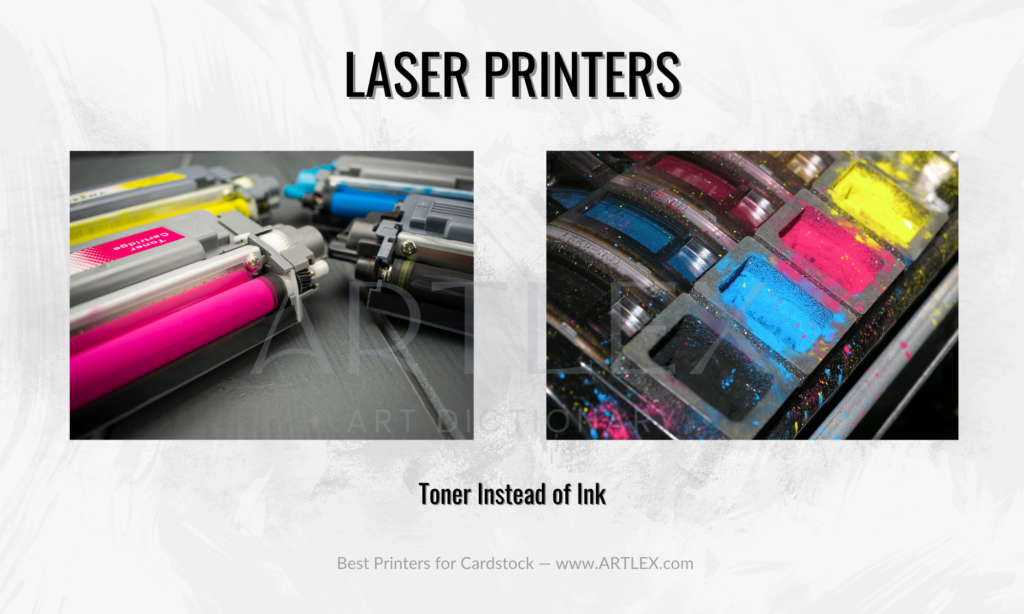
Toners are used in laser printers, and they work a bit differently from traditional inks. Unlike inks, which are liquid, toner is a fine powder composed of polyester—a type of plastic. It works by using heat to fuse the toner onto the paper. This unique method of printing leads to several distinctive attributes.
Firstly, toner-based prints are remarkably durable. Because the toner is essentially melted onto the page, it is resistant to smudging and fading, making it perfect for documents that need to be kept for a long time or used heavily. Furthermore, toner cartridges often have a larger yield than ink cartridges, meaning they can print more pages, which makes them a cost-effective solution for high-volume printing.
Price
Finally, we come to the aspect that can make or break your printer buying decision: the price. It’s not just about the upfront cost of the printer, though that’s obviously important. You also have to consider the running costs.
Ink or toner cartridges can be a significant expense in the long run. Research the cost of replacement cartridges for the printer models you’re considering and how many pages each cartridge can print before running out (this is known as the cartridge’s yield and it’s usually measuerd in pages).
Sometimes a cheaper printer can turn out to be more expensive over time due to the cost of frequent cartridge replacements. In contrast, a pricier printer might end up being more cost-effective if its cartridges have a higher yield and need to be replaced less frequently.
[faq_question_start]Cardstock FAQ
Q: What’s the difference between cardstock and regular paper?
A: Cardstock is thicker and heavier than regular paper. It’s used for a variety of crafting and printing projects that require a sturdier and more durable material. Regular paper is thinner and more flexible, making it suitable for everyday printing needs.
Q: What type of printer is best for cardstock?
A: The best printer for cardstock is one that can handle heavier paper weights. This often includes laser printers and some high-end inkjet models. Be sure to check your printer’s specifications to ensure it can handle the weight of the cardstock you plan to use.
Q: Can I use my regular home printer for cardstock?
Some home printers can handle cardstock, but it largely depends on the specific model and the weight of the cardstock. Check your printer’s manual to see if it is capable of handling cardstock and what weight it can take.
Q: What is the right way to load cardstock into a printer?
Cardstock should be loaded into the printer one sheet at a time to avoid jams. Also, make sure the cardstock is aligned properly in the tray. Your printer’s manual should have specific instructions on how to load specialty paper.
Q: How do I adjust my printer settings for cardstock?
A: Printer settings should be adjusted based on the weight and type of the cardstock. Typically, you’ll need to select a heavier paper type and possibly a higher print quality. Consult your printer’s manual for more specific instructions.
Q: Why are my prints smearing or not drying properly?
A: Smearing or slow drying prints can be due to several factors. The ink may not be compatible with the cardstock, the printer settings may not be adjusted correctly, or the print may not be given enough time to dry. Try adjusting your settings or allowing more time for prints to dry.
Q: Can I print double-sided on cardstock?
A: Yes, but this depends on your printer’s capabilities. Some printers offer automatic duplexing (double-sided printing), while others may require manual flipping of the cardstock. Also, remember that ink may show through on thinner cardstock when printing double-sided.
Q: Do I need to use specific ink for cardstock printing?
A: While you don’t necessarily need specific ink for cardstock, high-quality ink can provide better results. This includes more vibrant colors, sharper images, and prints that last longer without fading.
Q: What weight of cardstock should I use for my projects?
A: The weight of cardstock you should use depends on your project. Thicker cardstock (80 lb and above) is best for projects like greeting cards or invitations, while thinner cardstock (60 lb to 70 lb) is more suitable for things like flyers or handouts. Experiment to see what you prefer!
Q: Why does my printer keep jamming when I use cardstock?
A: Printer jams with cardstock are often due to the printer not being designed to handle the weight of the cardstock or not loading the cardstock properly. Make sure your printer is compatible with the weight of your cardstock, and try feeding the cardstock into the printer one sheet at a time.



